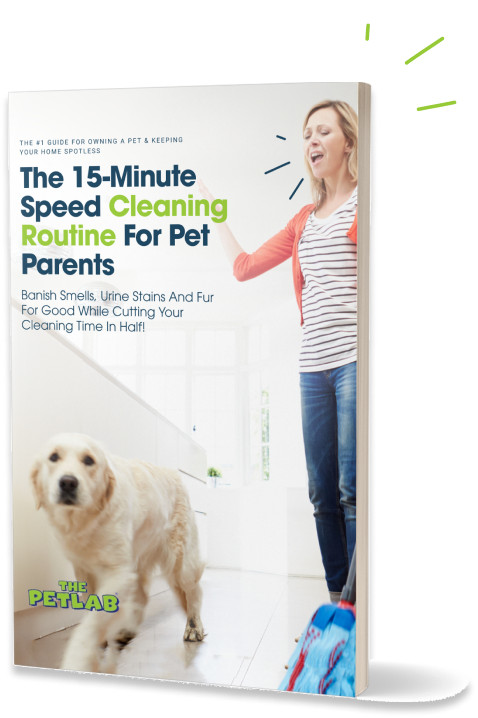Is Fido repeatedly dragging his bum across your shiny floors? That's not the latest TikTok dance craze! It's called scooting—and this weird conduct could mean it's time to see the vet. 🤔
What is scooting?
Scooting is a natural doggy reflex similar to how people scratch an itch. Some pet parents think it's icky. Others find it weird yet amusing. But scooting is rarely a reason to chuckle. This habit suggests discomfort and even pain in the area surrounding a pup's anal sacs.
About anal sacs
Anal sacs are small glands located near a canine’s rectum. Their job is to secrete a smelly liquid used in scent marking.
Just so you know, it's an unforgettable scent—and not in a good way. That rotten fish meets metallic smell stinks up the home, fast!
Tip: Fight foul and lingering odours with PetLab's enzyme-based Home Cleaning Starter Pack. It's the real deal when it comes to a fresh-smelling home.
Why do dogs scoot?
Scooting is more than a quirky quirk. It's a sign that something is bothering your doggo’s bottom. Here are the most common causes behind derrière distress.
Allergies
Certain foods, hypersensitivity to flea saliva, and environmental factors (like traditional cleaning products) can make your fur baby itch. While scratching and licking provide relief almost everywhere else on your doggy's body, the buttocks aren't within easy reach. But scooting hits the spot.
FYI: Irritation around the ears and rears are telltale signs of an allergy.
Grooming fails
Two words: Clipper burns. If you shave, you can relate. Similarly, dog hairs can easily snag. Sensitive canine skin can get injured from dull blades, overheated blades, or poor grooming technique. Strong chemicals in non-hypoallergenic products can cause skin irritation, itching, and soreness—including around a pup's hindquarters!
FYI: Dogs may also experience discomfort when soaps/shampoos aren't completely washed off.
Pooping problems
Diarrhoea and constipation are polar opposites, but both have ties to scooting.
► Soft stools don't exert enough pressure on doggy anal glands. That means anal sacs are only partially emptied or not emptied at all. 😧 The solution? Your dog has to shimmy its bum along the floor to get the job done.
► Scooting can also be a sign of constipation, especially when accompanied by vocalisation, circling, squatting, and unsuccessful poopy time.
FYI: Constantly straining to poop can cause a rare condition called rectal prolapse. That's when part of the large intestine protrudes out of the anus.
Pseudocoprostasis
That's the medical term for a blocked anal opening caused by messy, tangled, matted fur. Wait, that’s a thing?! Yep! It happens when poo gets stuck in the hairs around a canine's bottom. (So, scooting = wiping its bum.) Fortunately, things don't get that extreme overnight.
FYI: Long-haired dogs and those with poopy problems are more prone to bums affected by dirt, debris, and dingleberries. 😬
Anal sac disease
This is one of the most frequent causes of dog scooting behaviour and includes the following conditions.
► Impaction: This is when the anal sacs become blocked because they can't empty properly. Instead, the discharge that should be secreted builds up inside, getting thicker in consistency until it eventually causes discomfort.
► Abscessation: Impacted anal glands can get infected. You’ll spot redness, puss, and swelling near the anus. If the abscess bursts and goes untreated, it can damage your dog's rectum and anus! As you can imagine, this is terribly painful.
► Neoplasm: An abnormal growth of cells or tissues. Tumours can be benign (harmless) or malignant (cancerous). Nevertheless, anal sac cancers may grow and quickly spread to other areas, so puppers should be diagnosed and treated ASAP.
FYI: Anal sac disease is more common in flat-faced and small-breed dogs like Spaniels and Chihuahuas. Anal gland cancer is more common in Spaniels, German Shepherds, Alaskan Malamutes, and Dachshunds.
Intestinal parasites
Pups can contract all kinds of worms—roundworms, hookworms, tapeworms—from everyday activities like sniffing/eating excrement, hunting rodents, and ingesting fleas. As parasites exit the body (hitching a ride in faeces), doggy bottoms may itch and feel uncomfortable. Scooting offers relief.
FYI: Parasites are preventable with regular deworming and flea prevention.
Dog scooting may be the butt of the joke every now and then, but it’s also your cue to pay attention. 🧐 When in doubt, consult your vet for further assistance.
Disclaimer: This post is for informational purposes only. It is not and does not intend to be a substitute for professional veterinarian advice, diagnosis, or treatment. Reliance on any information on this website is at your own risk. Always consult with your veterinarian.


